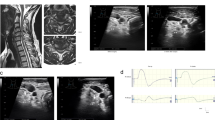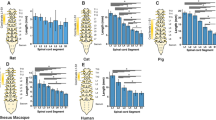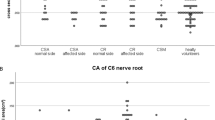Abstract
Study design:
Histological examination of human spinal ventral roots.
Objectives:
To determine the proportion of unmyelinated fibers in human ventral roots from the 4th cervical (C4) to 2nd sacral (S2) segment, and to evaluate differences in the proportions of unmyelinated fibers between the cervical, thoracic, lumbar and sacral segments, and between autonomic and other segments.
Setting:
University Teaching Hospital, Busan, Korea.
Methods:
Eight embalmed adult human cadavers (six males and two females; mean age 56.3 years) were collected. The ventral root samples were obtained by transverse cuts of the ventral roots within 1 cm proximal to the medial portion of the dorsal root ganglion from the C4 to S2 segment. The number of unmyelinated and myelinated fibers was counted in four fields, and the mean number of unmyelinated fibers was calculated. The percentage of unmyelinated fibers was calculated from the ratio of unmyelinated fibers to total fibers (myelinated fibers+unmyelinated fibers).
Results:
The mean percentages of unmyelinated axons in cervical (C4–C8), thoracic (T1–T12), lumbar (L1–L5) and sacral (S1–S2) ventral roots were 16.3, 21.4, 17.8 and 20.7%, respectively. The percentage of unmyelinated fibers in thoracic ventral roots was higher than that for other segments (P<0.001). There was no significant difference in proportions of unmyelinated fibers between the sympathetic segments (T11–L2), parasympathetic segments (S2) and the other segments (C4–T10 and L3–S1) (P=0.1784).
Conclusions:
Approximately 20% of human spinal ventral root fibers were unmyelinated. The proportion of unmyelinated fibers was highest in the thoracic segments.
Similar content being viewed by others
Introduction
On the basis of original descriptions by Bell1 and Magendie,2 spinal roots are classically functionally divided into dorsal roots for sensory transmission and ventral roots for motor transmission. The ventral root is composed of axons from three motoneuronal types—α, γ and preganglionic autonomic motoneurons—and all three are generally believed to be myelinated. However, this assumption has been questioned for many years. Some reports in the 1930s and 1940s described unmyelinated fibers in the ventral roots, and many subsequent studies have raised questions regarding this issue.3, 4, 5, 6, 7, 8, 9, 10
Coggeshall et al.6 and Risling et al.9 reported that nearly 30% of ventral root axons in the L7 and S1 roots of the cat were unmyelinated and originated from cell bodies in the dorsal root ganglia. In humans, 13–51% of fibers in the ventral roots are unmyelinated.11, 12 Sykes and Coggeshall12 reported that 30% of all axons in the human L4 and L5 ventral roots are unmyelinated.
Hosobuchi8 described three cases of dorsal rhizotomy failing to provide relief from intractable pain. Following extensive dorsal rhizotomy, approximately 25% of the total ventral root axons were found to be unmyelinated. The removal of the dorsal root ganglia resulted in marked pain reduction. Those findings suggest that the majority of unmyelinated axons in the ventral roots probably conduct nociceptive information. Chung and Kang13 found that the majority of ventral root afferent fibers originate from the dorsal root ganglia and are unmyelinated or small myelinated axons. The presence of unmyelinated fibers in ventral roots was determined by several physiological and anatomical investigations,4, 13, 14, 15, 16, 17 which suggests that a large proportion of ventral root fibers may be sensory. The ventral roots of cats and humans are similar, in that they appear to have significant numbers of unmyelinated fibers. In contrast, in rats only the T1–L3 and L6–S1 ventral roots contain unmyelinated axons, which are the roots of sympathetic and parasympathetic outflow in this species.15
Although a large number of primary afferent fibers have been found in the spinal ventral roots of mammals, the origin, destination, physiological properties and functional significance of these afferent fibers is not yet clear.13 Furthermore, anatomical studies of the unmyelinated human ventral root fibers examined differences according to the regional segments; segments involved in sympathetic or parasympathetic outflows and between sympathetic and parasympathetic segments have not been performed.
In this study, we determined the proportion of unmyelinated fibers in each human ventral root segment, and evaluated the differences between sympathetic and parasympathetic segments and other segments.
Materials and methods
Anatomic material was collected from eight embalmed Korean adult human cadavers (six males and two females, mean age at death 56.3 years). The patients had no history of neurological defects. The spinal cord and roots were exposed by laminectomies and facetectomies bilaterally from the C2 to S1 vertebrae. The 4th cervical (C4) to 2nd sacral (S2) ventral roots were exposed. For each ventral root, one side of the C4–S2 ventral roots was cut just proximal (within 1 cm) to the dorsal root ganglion, and approximately 0.5 cm segment samples were obtained by transverse cutting of the ventral root. Luxol fast blue-stained, semi-thin sections of the entire sectional area of the ventral root samples were examined under light microscopy, and the number of myelinated and unmyelinated fibers was counted. The mean percentage of unmyelinated fibers in four fields ( × 400) was calculated (Figure 1). The percentage of unmyelinated fibers in each field was calculated from the ratio of unmyelinated fibers to total fibers (myelinated fibers+unmyelinated fibers) in the sample. The T11–L2 and S2 segments were considered sympathetic and parasympathetic segments, respectively.
The differences in the percentages of unmyelinated fibers between the ventral roots of the segments were analyzed using the Kruskal–Wallis tests and Mann–Whitney tests on SPSS software (version 10.0, SPSS, Chicago, IL, USA). P-values <0.05 were considered to indicate a significant difference.
Results
Light microscopic examination of stained sections showed that the mean percentage of unmyelinated axons in cervical, thoracic, lumbar and sacral ventral roots was 16.3, 21.4, 17.8 and 20.7%, respectively. The percentage of unmyelinated fibers in the thoracic ventral roots was higher than for the cervical and lumbar segments (Table 1) (P<0.001). There were no significant differences between the T11–L2 and S2 and other segments (P=0.1784). Similarly, there was no significant difference between the sympathetic segments (T11–L2) and the parasympathetic segment (S2) (Table 2) (P=0.566). The T1 ventral root has the highest percentage of unmyelinated fibers of the ventral roots, C4–S2. For the cervical, thoracic and lumbar segments, the highest proportion of ventral root unmyelinated fibers was found in the C6, T1 and L1, respectively (Figure 2). The average percentage of unmyelinated fibers in the human ventral roots of all segments studied was 19.6±4.5.
Discussion
Frequent failure of dorsal rhizotomy to manage intractable pain may be due to primary afferent pain fibers in the ventral root.18 Hosobuchi8 and Coggeshall et al.11 confirmed the long-held notion that ventral roots might constitute a separate pain pathway, which could explain why dorsal rhizotomy is not always successful for pain relief even acutely. Coggeshall et al.6 observed that these unmyelinated axons were reduced in number proximal but not distal to a ventral rhizotomy, and decreased following dorsal root ganglionectomy. They concluded that the ventral roots of the lumbosacral enlargement contain a large number of unmyelinated fibers originating from dorsal root ganglion cells. Coggeshall's hypothesis that ventral roots contain sensory axons gained support from the finding that many ventral root C-fibers disappear after dorsal root ganglionectomy.6, 19
Coggeshall et al.5 reported that unmyelinated axons constitute approximately 30% of fibers in the T11, T12, L7 and S1 ventral roots of the cat. Their observations of the L7 and S1 ventral roots suggested that unmyelinated fibers in ventral roots are not preganglionic autonomic efferents, as the unmyelinated axons project toward the spinal cord.5 These observations were confirmed by examining myelinated and unmyelinated fibers in cat ventral root sections. Although there was no decrease in myelinated fibers proximal to the ventral root cut, the number of unmyelinated fibers was greatly reduced. By contrast, distal to the cut, there was no significant decrease in unmyelinated fibers.5 On average, 34% of axons in the normal S3 ventral root and 32% of those in the S4 ventral root were unmyelinated.5
Variable distribution also occurs in the rat where the ventral roots T1–L2, L6 and S1 contain more unmyelinated and small myelinated axons compared with the segments C1–C8 and L3–L5.15 In the T11 and T12 ventral roots of the cat, slightly less than half of the unmyelinated fibers are efferents with the majority arising from dorsal root ganglion cells. The efferent fibers are regarded as unmyelinated preganglionic sympathetic, and the fibers of dorsal root ganglion origin, of course, are regarded as sensory in the T11 and T12 ventral roots.20 The unmyelinated fibers in the ventral roots of the cat sympathetic and parasympathetic outflows are similarly arranged. The overall percentage of these axons in the two types of roots is approximately 30%, and there are two functional categories of preganglionic efferents and sensory fibers.20 By contrast, the unmyelinated axons in the roots between the outflows (L7 and S1) are primarily sensory in nature.20
Three reports have proposed the course of ventral root afferent fibers.4, 10, 17 The most likely scenario is that cells of the dorsal root ganglion project to the ventral root and then loop back out to the ganglion.4, 10, 17 This projection pattern of the dorsal root ganglion cell is based on the evidence of a gradual decrease in the number of unmyelinated fibers in the ventral root proximally.10 Karlsson et al.21 reported that the proportion of unmyelinated fibers in the L7 root of owl monkey decreased nearer to the spinal cord, from 19% distally to 5% in the juxtamedullary rootlets.
At thoracic and lower sacral levels, many of the unmyelinated fibers are likely to represent sympathetic or parasympathetic efferents. Some investigators have assumed that the unmyelinated fibers in the ventral root originated from preganglionic autonomic motoneurons.7, 22 Axons in spinal segments T11 and T12 of the cat, which contain part of the sympathetic outflow, are an example.20 Coggeshall et al.15 demonstrated that approximately 30% of the axons in the L6 and S1 ventral roots in the rat are unmyelinated. Of these, 30% unmyelinated axons originated from dorsal root ganglion cells, whereas the remaining 70% (10% of the total axon number) originated from the spinal cord and are presumably preganglionic parasympathetic fibers. However, debate continues on the processes of dorsal root ganglion cells.
This study does not provide information regarding the function of unmyelinated fibers in ventral roots. The present findings are consistent with those of others examining spinal ventral roots in animals and humans. We found that the proportion of unmyelinated fibers was highest in the thoracic ventral roots, and that approximately 20% of human spinal ventral roots were unmyelinated. Our findings may have clinical relevance regarding pain upon irritation of ventral roots. We believe the present findings indicate that further study is warranted on the clinical significance of the high proportion of unmyelinated fibers found in thoracic segments, and on the physiological characteristics of unmyelinated fibers found in sympathetic and parasympathetic spinal cord segments.
References
Bell C . An Idea of a New Anatomy of the Brain. A Privated Printed Pamphlet. Strahan & Preston: London, 1811.
Magendie F . Experiences sur les fonctions des racines des nerfs rachidiens. J Physiol Exp 1822; 2: 276–279.
Applebaum ML, Clifton GL, Coggeshall RE, Coulter JD, Vance WH, Willis WD . Unmyelinated fibres in the sacral 3 and caudal 1 ventral root of the cat. J Physiol 1976; 256: 557–572.
Azerad J, Hunt CC, Laporte Y, Dollin B, Tiesson D . Afferent fibres in cat ventral roots: electrophysiological and histological evidence. J Physiol 1986; 379: 229–243.
Coggeshall RE, Coulter JD, Willis Jr WD . Unmyelinated fibers in the ventral root. Brain Res 1973; 57: 229–233.
Coggeshall RE, Coulter JD, Willis Jr WD . Unmyelinated axons in the ventral roots of the cat lumbosacral enlargement. J Comp Neurol 1974; 153: 39–58.
Duncan D . A determination of the number of unmyelinated fibers in the ventral roots of the rat, cat and rabbit. J Comp Neurol 1932; 1932: 459–471.
Hosobuchi Y . The majority of unmyelinated afferent axons in human ventral roots probably conduct pain. Pain 1980; 8: 167–180.
Risling M, Aldskogius H, Hildebrand C . Effects of sciatic nerve crush on the L7 spinal roots and dorsal root ganglia in kittens. Exp Neurol 1983; 79: 176–187.
Risling M, Hildebrand C . Occurrence of unmyelinated axon profiles at distal, middle and proximal levels in the ventral root L7 of cats and kittens. J Neurol 1982; 56: 219–231.
Coggeshall RE, Applebaum ML, Fazen M, Stubbs TB, Sykes MT . Unmyelinated axons in human ventral roots, a possible explanation for the failure of dorsal rhizotomy to relieve pain. Brain 1975; 98: 157–166.
Sykes MT, Coggeshall RE . Unmyelinated fibers in the human L4 and L5 ventral roots. Brain Res 1973; 63: 490–495.
Chung K, Kang HS . Dorsal root ganglion neurons with central processes in both dorsal and ventral roots in rats. Neurosci Lett 1987; 80: 202–206.
Clifton GL, Coggeshall RE, Vance WH, Willis WD . Receptive fields of unmyelinated ventral root afferent fibres in the cat. J Physiol 1976; 256: 573–600.
Coggeshall RE, Maynard CW, Langford L . Unmyelinated sensory and preganglionic fibers in rat L6 and S1 ventral spinal roots. J Comp Neurol 1980; 193: 41–47.
Mawe GM, Bresnahan JC, Beattie MS . Primary afferent projections from dorsal and ventral roots to autonomic preganglionic neurons in the cat sacral spinal cord: light and electron microscopic observations. Brain Res 1984; 290: 152–157.
Risling M, Dalsgaard CJ, Cukierman A, Cuello AC . Electron microscopic and immunohistochemical evidence that unmyelinated ventral root axons make u-turns or enter the spinal pia mater. J Comp Neurol 1984; 225: 53–63.
Loeser JD . Dorsal rhizotomy for the relief of chronic pain. J Neurosurg 1972; 36: 745–750.
Wee BE, Emery DG, Blanchard JL . Unmyelinated fibers in the cervical and lumbar ventral roots of the cat. Am J Anat 1985; 172: 307–316.
Emery DG, Ito H, Coggeshall RE . Unmyelinated axons in thoracic ventral roots of the cat. J Comp Neurol 1977; 172: 37–47.
Karlsson M, Hildebrand C, Warnborg K . Fibre composition of the ventral roots L7 and S1 in the owl monkey (Aotus trivirgatus). Anat Embryol (Berl) 1991; 184: 125–132.
Matthews MA . An electron microscopic study of the relationship between axon diameter and the initiation of myelin production in the peripheral nervous system. Anat Rec 1968; 161: 337–351.
Acknowledgements
This study was partly supported by the Medical Research Institute of Pusan National University Hospital.
Author information
Authors and Affiliations
Corresponding authors
Rights and permissions
About this article
Cite this article
Ko, HY., Shin, Y., Sohn, H. et al. Unmyelinated fibers in human spinal ventral roots: C4 to S2. Spinal Cord 47, 286–289 (2009). https://doi.org/10.1038/sc.2008.97
Received:
Revised:
Accepted:
Published:
Issue Date:
DOI: https://doi.org/10.1038/sc.2008.97
Keywords
This article is cited by
-
Acupuncture as Neuromodulation: How It Can Explain Ancient and Modern Acupuncture Paradoxes
Chinesische Medizin / Chinese Medicine (2020)





